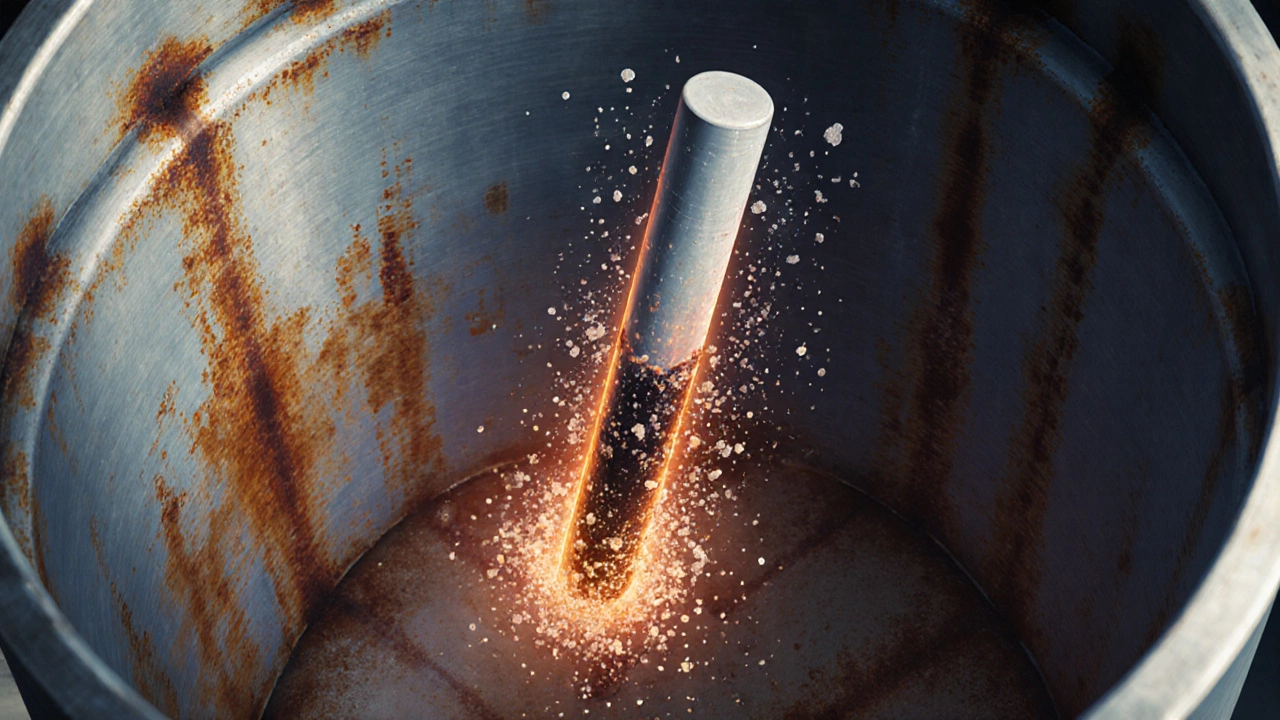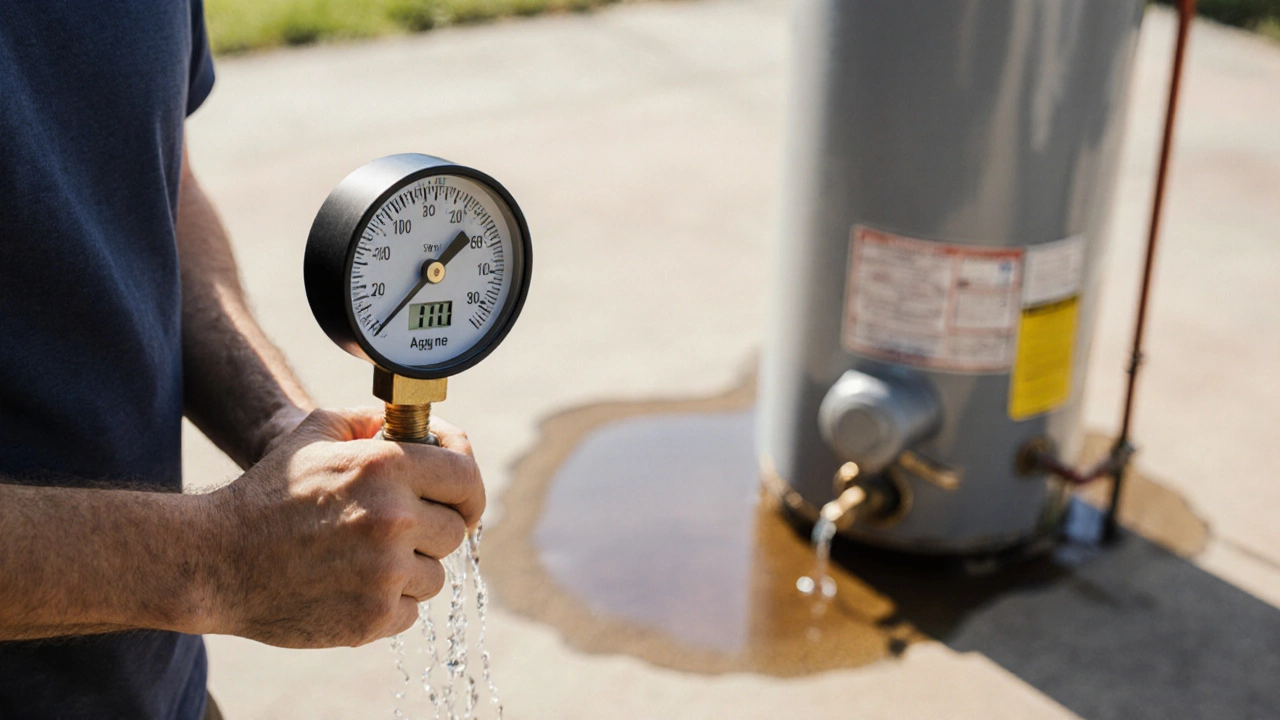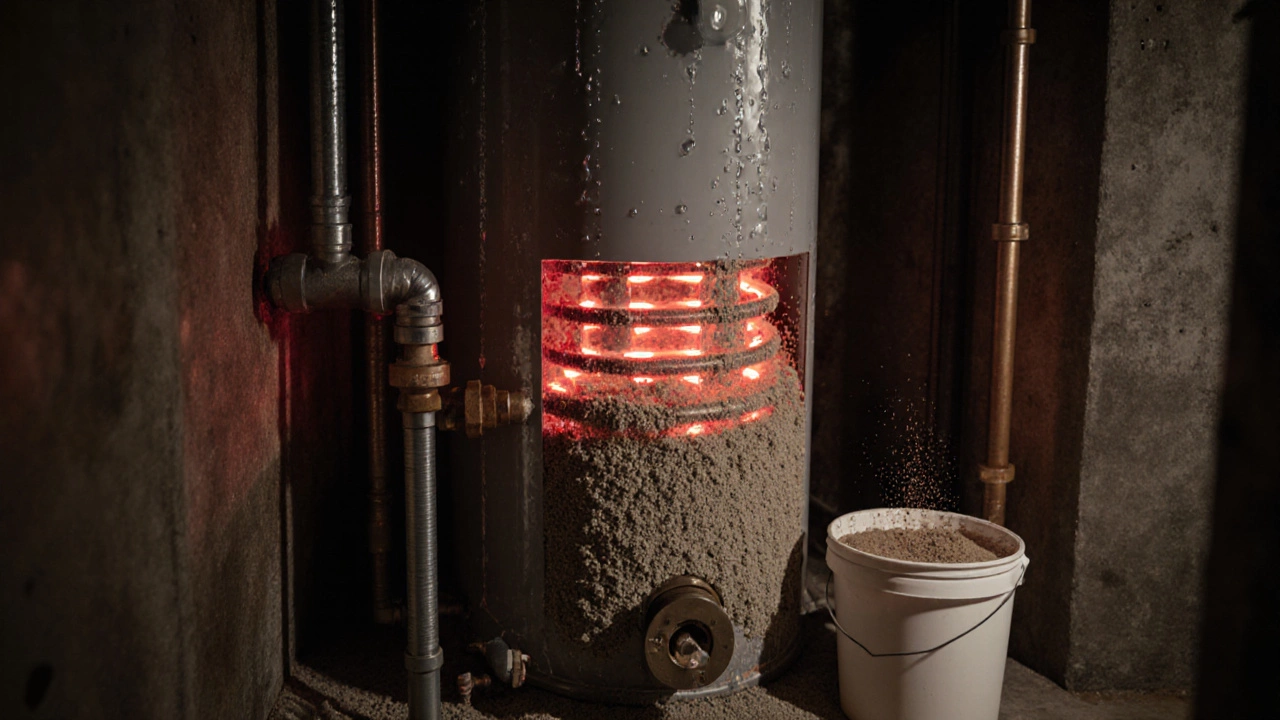Most people expect their water heater to last 10 to 15 years. But in Dunedin, where hard water is common and winters are cold, many homeowners see their water heater give out before the five-year mark. It’s not bad luck. It’s not poor quality. It’s usually the same five things, happening over and over again.
Sediment buildup is the silent killer
Every time you heat water, minerals like calcium and magnesium drop out of solution and sink to the bottom of the tank. Over time, this builds up into a thick layer of sediment-sometimes several inches deep. That layer doesn’t just sit there. It acts like insulation between the heating element (or gas burner) and the water. The heater has to work harder, longer, and hotter to get the water warm. That extra strain burns out the element faster. In electric tanks, the bottom element often dies first because it’s buried under sludge. In gas models, the tank’s bottom plate overheats and starts to rust through.
One homeowner in Portobello replaced their water heater every four years until they finally flushed the tank. The sediment they drained out was enough to fill a large coffee mug. After that, their new heater lasted eight years without a single issue. Flushing once a year doesn’t take long. It’s just a hose, a bucket, and 20 minutes.
The anode rod isn’t just a part-it’s your heater’s bodyguard
Inside every water heater is a magnesium or aluminum rod hanging from the top. This is the anode rod. Its job? To attract corrosive elements in the water so they eat the rod instead of your steel tank. Think of it like a sacrificial lamb. When the rod is gone, the tank starts rusting from the inside out. And once that happens, no amount of flushing will save it.
Most manufacturers install a standard anode rod that lasts about 3 to 5 years. But in areas with hard water or high mineral content-like Dunedin’s groundwater-the rod can disappear in under two years. Check it every 18 months. If it’s more than half eaten away, replace it. A new rod costs $30. Replacing it yourself takes an hour. Letting it go costs you $1,200 for a new heater.
High water pressure tears things apart
Water pressure should sit between 40 and 60 psi. Anything above 80 psi is dangerous. High pressure doesn’t just stress pipes-it shakes the water heater’s internal components. The seams, the valves, the temperature-pressure relief valve-all of them get pounded. Over time, this leads to tiny leaks that turn into big ones.
Most homes don’t have a pressure-reducing valve installed. If your water heater failed suddenly and you saw water pooling around the base, check your pressure. You can buy a simple gauge at any hardware store for under $15. Screw it onto an outdoor tap or washing machine connection. If it reads over 70 psi, you need a pressure-reducing valve. It’s not expensive. It’s not complicated. But it’s often ignored until the tank bursts.

Thermostat settings that are too high
Many people turn the thermostat up to ‘hot’ because they think it means more hot water. It doesn’t. It just means more scale, more corrosion, and more stress on the tank. Every 10-degree increase above 60°C doubles the rate of mineral buildup and accelerates corrosion. The ideal setting is 60°C. That’s hot enough to kill bacteria like Legionella, but not so hot that it cooks your tank from the inside.
One family in Mosgiel kept their heater at 75°C because they thought their shower wasn’t hot enough. Their anode rod vanished in 14 months. Their tank rusted through after 4 years. They lowered the temp to 60°C, replaced the rod, and their next heater is still going strong after six years.
Ignoring small leaks and strange noises
Water heaters don’t usually die without warning. They scream before they fall. A popping or crackling sound? That’s sediment boiling under the heating element. A hissing sound near the base? That’s a slow leak from a rusted tank. A dripping T&P valve? That’s either high pressure or a faulty valve. All of these are red flags.
People often wait until the heater stops working completely. Then they panic. They call someone on a Saturday night. They pay triple. And they get a replacement that fails again in three years because they didn’t fix the root cause.
Don’t wait for disaster. If you hear anything unusual, or see even a drop of water where there shouldn’t be one, investigate. Drain a bucket of water from the bottom valve. Look for grit. Check the anode rod. Test the pressure. These are free diagnostics. They cost nothing but time. And time is the one thing you can’t get back once the tank bursts.

What you can do right now
If your water heater is older than three years, here’s your action list:
- Turn off the power or gas.
- Attach a hose to the drain valve at the bottom and flush out 5 litres of water. Look for sand, rust, or chunks. If you see any, you need regular flushing.
- Locate the anode rod (usually on top of the tank under a cap). Unscrew it. If it’s thin, brittle, or covered in hard deposits, replace it.
- Check your water pressure with a gauge. If it’s above 70 psi, install a pressure-reducing valve.
- Set the thermostat to 60°C. No higher.
Do this once a year. It takes less time than watching an episode of your favorite show. And it could double the life of your water heater.
When to replace-not repair
Some repairs are worth it. Replacing the anode rod? Always. Fixing a leaky valve? Yes. But if your tank is over eight years old and you’re seeing rust on the outside, or if you’ve had to flush it twice in one year, replacement is smarter than repair. A new tank costs $800-$1,500 installed. But a new one with a 10-year warranty and a good anode rod will outlast three old ones.
Don’t fall for the myth that ‘if it’s still working, don’t fix it.’ Water heaters don’t fail suddenly. They fail slowly. And by the time you notice, it’s already too late.
Stop treating your water heater like a disposable appliance. Treat it like the critical piece of infrastructure it is. Give it a little care, and it’ll give you a decade of reliable hot water.
Why does my water heater make popping sounds?
Popping or crackling sounds mean sediment has built up at the bottom of the tank. When the heating element turns on, it heats the water trapped under the sludge, causing it to boil and bubble. This creates the noise. Flushing the tank removes the sediment and stops the sound.
How often should I flush my water heater?
Flush your water heater at least once a year. In areas with hard water, like Dunedin, do it every six months if you notice gritty water or reduced hot water output. Regular flushing prevents sediment buildup, which is the leading cause of premature failure.
Can I replace the anode rod myself?
Yes. Most anode rods unscrew from the top of the tank using a socket wrench. Turn off the power or gas and shut off the water supply first. Drain a few litres to reduce pressure. The rod is usually 3/4 inch in diameter and 3 to 4 feet long. Replacement rods cost under $40. If you’re unsure, take a photo of the old one to a plumbing supplier-they’ll match it.
Is a tankless water heater better for avoiding failure?
Tankless heaters avoid sediment buildup because they don’t store water. But they’re more sensitive to hard water. Without a water softener, mineral deposits can clog the heat exchanger. They also cost more upfront and require professional installation. For most homes, a well-maintained tank heater lasts just as long as a tankless one-often longer-if you flush it and replace the anode rod regularly.
What’s the ideal temperature for a water heater?
Set your water heater to 60°C. That’s hot enough to prevent harmful bacteria like Legionella from growing, but not so hot that it accelerates corrosion or mineral buildup. Higher temperatures waste energy and shorten the heater’s life. Lower temperatures risk bacterial growth and may not be hot enough for dishwashers or showers.
Should I install a water softener to protect my water heater?
If your water is very hard (over 180 mg/L calcium carbonate), a softener helps reduce scale. But it’s not always necessary. Regular anode rod replacement and annual flushing are more cost-effective for most households. Softeners add ongoing maintenance, salt costs, and can corrode pipes if not maintained. Only install one if you have severe scaling, frequent element failures, or very low water pressure due to clogged pipes.
Next steps if your heater is already failing
If your water heater is leaking, making loud noises, or not heating properly, don’t wait. Turn off the power or gas and shut off the water supply. Then drain the tank if possible. This stops further damage and prevents flooding. Call a professional to assess whether repair is worth it-or if replacement is the smarter move.
Don’t assume your next heater has to fail too. Most failures are preventable. It’s not about buying the most expensive model. It’s about understanding how your water heater works-and giving it the basic care it needs to last.
